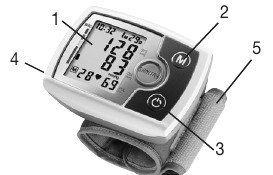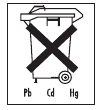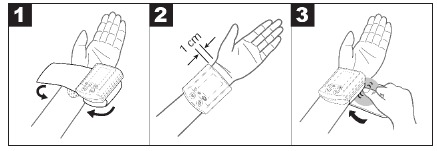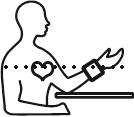
F Mode d’emploi
Tensiomètre ……………….. . 19– 26
I
Instruzioni per l´uso
Misuratore di pressione . . . . . . . . . . . . 27 – 34
r
Инструкция по применению
Прибордляизмерениядавления
назапястье35–44
Serviceadresse:
Hans Dinslage GmbH
Riedlinger Straße 28
88524 Uttenweiler, GERMANY
Tel.-Nr.: (0) 7374—915766
Fax-Nr.:
(0)
7374-920723
E-Mail: service@sanitas-online.de
SBM 03
Sanitas SBM 03 — Blood Pressure Monitor Manual
Introduction
Please read these instructions for use carefully and keep them for later use, be sure to make them accessible to other users and observe the information they contain.
Getting to know your instrument
The wrist blood pressure monitor is used for non-invasive measurement and monitoring of adults’ arterial blood pressure.
You can use it to measure your blood pressure quickly and easily, storing the results and displaying the progression of readings. A warning is issued for anyone suffering from cardiac arrhythmia.
The values determined are classified and graphically evaluated according to WHO guidelines. Keep these instructions carefully for further use and also let other users have access to them.
The following symbols are used in these instructions for use, on the packaging and on the type plate for the device and accessories:
| |
Caution |
| |
Note Note on important information |
 |
Follow instructions for use |
 |
Type BF applied part |
 |
Direct current |
 |
Disposal in accordance with EC Directive – WEEE (Waste Electrical and Electronic Equipment). |
 |
Manufacturer |
 |
Permissible storage temperature and humidity |
 |
Permissible operating temperature and humidity |
 |
Keep dry |
| SN | Serial number |
 |
The CE labelling certifies that the product complies with the essential requirements of Directive 93/42/EEC on medical products. |
Advice on use
- In order to ensure comparable values, always measure your blood pressure at the same time of day.
- Before every measurement, relax for about five minutes.
- If you want to perform several measurements on the same person, wait five minutes between each measurement.
- Do not take a measurement within 30 minutes after eating, drinking, smoking or exercising.
- Repeat the measurement if you are unsure of the measured value.
- The measurements taken by you are for your infor-mation only – they are not a substitute for a medical examination! Discuss the measurements with your doctor, and never base any medical decisions on them (e.g. medicines and their administration)!
- Do not use the blood pressure monitor on newborns or patients with preeclampsia. We recommend consulting a doctor before using the blood pressure monitor during pregnancy.
- In the case of restricted circulation on the arm as a result of chronic or acute vascular diseases (including vascular constriction), the accuracy of the wrist measurement is limited. In this case you should avoid using an upper arm blood pressure monitor.
- Cardiovascular diseases may lead to incorrect meas-urements or have a detrimental effect on measurement accuracy. The same also applies to very low blood pressure, diabetes, circulatory disorders and arrhythmias as well as chills or shaking.
- The blood pressure monitor must not be used in con-nection with a high-frequency surgical unit.
- Only use the unit on people who have the specified wrist measurement for the device.
- Please note that when inflating, the functions of the limb in question may be impaired.
- During the blood pressure measurement, blood circu-lation must not be stopped for an unnecessarily long time. If the device malfunctions, remove the cuff from the arm.
- Do not allow sustained pressure in the cuff or frequent measurements. The resulting restriction of the blood flow may cause injury.
- Ensure that the cuff is not placed on an arm in which the arteries or veins are undergoing medical treatment, e.g. intravascular access or therapy, or an arteriovenous (AV) shunt.
- Do not use the cuff on people who have undergone a mastectomy.
- Do not place the cuff over wounds as this may cause further injury.
- The blood pressure monitor can only be operated with batteries.
- To conserve the batteries, the monitor switches off automatically if no buttons are pressed for one minute.
- The device is only intended for the purpose described in these instructions for use. The manufacturer is not liable for damage resulting from improper or careless use.
Storage and Care
- The blood pressure monitor is made up of precision electronic components. Accuracy of readings and the instrument’s service life depend on careful hand ling.
- You should protect the device from impact, moisture, dirt, major temperature fluctuations and direct exposure to the sun’s rays.
- Never drop the device.
- Do not use near strong electromagnetic fields, i.e. keep it away from any radio systems and mobile phones.
- Only ever use the cuffs provided with the monitor or original replacement cuffs. Otherwise erroneous results will be recorded.
- Do not press any buttons until the cuff is in position.
- If the instrument is not used for any length of time, we recommend removing the batteries.
Advice on batteries
- Batteries can be fatal if swallowed. You should there-fore store the batteries and products where they are inaccessible to small children. If a battery has been swallowed, call a doctor immediately.
- Batteries should not be charged or reactivated with any other means, nor should they be taken apart, thrown in the fire or short-circuited.
- Remove the batteries from the instrument if they are worn out or if you are not going to use the instrument for any length of time. This prevents any damage as a result of leakage. Always replace all the batteries at the same time.
- Never use different types of battery, battery brands or batteries with different capacities. You should preferably use alkaline batteries.
Repair and disposal
- Batteries do not belong in domestic refuse. Used batteries should be disposed of at the collection points provided.
- Never open the instrument. If these instructions are not heeded, the warranty will be null and void.
- Never attempt to repair the instrument or adjust it yourself. We can no longer guarantee perfect functioning if you do.
- Repairs may only be performed by Customer Service or authorized dealers. However, always check the batteries and replace them if necessary prior to making any complaint.
-
The appliance should be disposed of accor ding to Regulation-WEEE (Waste Electrical and Electronic Equipment). In case of queries, please contact the municipal authorities responsible for waste disposal in your area.
Unit description
- Display
- Memory button M
- START/STOP
- Battery cover
- Wrist cuff
Icons in the display
- Time and date
- Systolic pressure
- Diastolic pressure
- mmHg unit
- Measured pulse
- Pulse icon
- Number of memory space
- Inflate/deflate arrow
- Change battery icon
- Cardiac arrhythmia icon
- WHO classification
Prepare measurement
Inserting battery
- Remove the battery cover (left side of the unit).
- Insert two 1.5 V micro batteries (alkaline, type LR 03).
Make absolutely sure that you insert the batteries with the correct polarity as marked.
Do not use rechargeable batteries. - Replace the battery cover carefully.
If the change battery icon is displayed, measurement is no longer possible and you must replace all the batteries.
Used batteries do not belong in the household waste. You are legally obliged to dispose of the batteries. Dispose of them via your specialist electrical supplier or local collec ting point for recyclable waste.
Note:
You will find these markings on batteries containing harmful substances: Pb = battery containing lead, Cd = battery containing cadmium, Hg = battery containing mercury.
Setting date and time
It is vital to set date and time. Only in this way is it possible to save and subsequently retrieve your measured values with the right date and time.
Time is shown in 24 hour format.
Note:
If you hold down M, you can set the values faster.
Measuring blood pressure
Positioning cuff
- Bare your left wrist, making sure that the circulation in the arm is not restricted by any clothes etc. that are too tight. Position the cuff on the inside of your wrist.
- Fasten the cuff with the Velcro fastening so that the upper edge of the monitor is positioned approx. 1 cm below the ball of your thumb.
- The cuff has to be fitted tightly around the wristbut should not constrict it.
The instrument should only be operated with the original cuff.
Correct posture
- Rest for approx. 5 minutes before each measurement. Otherwise there may be divergences.
- You can perform the measurement while sitting or lying. To carry out a blood pressure measurement, make sure you are sitting comfortably with your arms and back leaning on something. Do not cross your legs.
Place your feet flat on the ground. Make sure to rest your arm and move it. Always make sure that the cuff is at heart level. Otherwise significant deviations can occur. Relax your arm and the palm of your hand. - In order not to distort the result, it is important to keep still during the measurement and not talk.
Measuring blood pressure
Evaluating results
Cardiac arrhythmia:
This instrument can identify possible cardiac arrhythmia disorders during measurement and if necessary indicates the measurement with the flashing icon .
This may be an indicator for arrhythmia. Arrhythmia is a condition where the heart rhythm is abnormal as a result of defects in the bioelectrical system controlling the heart beat. The symptoms (omitted or premature heart beats, slow or excessively fast heart rate) may be caused, among other things, by heart disease, age, physical predisposition, excessive use of stimulants, stress or lack of sleep. Arrhythmia can only be ascertained through examination by your doctor.
Repeat the measurement if the flashing icon is displayed after the measurement. Please note that you should rest for 5 minutes between measurements and not talk or move during the measurement. If the icon
appears often, please contact your doctor. Any self-diagnosis and treatment based on the test results may be dangerous. It is vital to follow your doctor’s instructions.
WHO classification:
In accordance with the guidelines/definitions of the World Health Organization and the latest findings, the measurements can be classified and assessed according to the following table.
However, these standard values serve only as a general guideline, as the individual blood pressure varies in different people and different age groups etc.
It is important to consult your doctor regularly for advice.
Your doctor will tell you your individual values for normal blood pressure as well as the value above which your blood pressure is classified as dangerous.
| Range of blood pressure values | Systolic (in mmHg) | Diastolic (in mmHg) | Measure |
| Grade 3: Severe hypertension | ≥180 | ≥110 | Seek medical advice |
| Grade 2: Moderate hypertension | 160 -179 | 100 -109 | Seek medical advice |
| Grade 1: Mild hypertension | 140 -159 | 90 — 99 | Have it checked regularly by doctor |
| High-normal | 130 -139 | 85 — 89 | Have it checked regularly by doctor |
| Normal | 120 -129 | 80 — 84 | Check it yourself |
| Optimal | <120 | <80 | Check it yourself |
* Source: WHO, 1999
According to WHO Guidelines/Definitions and the latest findings, the test results can be classified and evaluated according to the following chart.
The bar graph in the display and the scale on the unit indicate the range of the blood pressure which has been recorded. An accoustic evaluation of your measurement also follows.
If the values for systolic and diastolic pressure are in two different WHO ranges (e.g. systolic in the high-normal range and diastolic pressure in the normal range) the graphic WHO classification on the unit indicates the higher range (high-normal in the example described).
Saving, retrieving and deleting results
- The results of each successful measurement are stored together with date and time. With more than 60 items of measured data, the earliest items of data measured are lost.
- In order to retrieve measurement results again, press the memory button M. The instrument first displays the number of memory spaces occupied and then automatically switches to the last saved test result. If you continue pressing the memory button M, the last results in each case are measured are displayed with date, time and graphic WHO classification.
- You can clear the memory by holding down the mem-ory button M for 3 seconds.
Error messages/troubleshooting
In case of faults, the 
Error messages may appear if:
In the above cases, you must repeat the measurement.
Reinsert the batteries if necessary, or else replace them.
Technical alarm – description
Should the recorded blood pressure (systolic or diastolic) lie outside the limits specified in the section «Technical specifications», the technical alarm will appear on the display indicating either 

The limit values for the technical alarm are factory set and cannot be adjusted or deactivated. These alarm limit values are accorded second priority under the standard IEC 60601-1-8.
The technical alarm is a non-locking alarm and must not be reset. The signal shown on the display will disappear automatically after about 8 seconds.
Cleaning and Care
- Clean your blood pressure monitor carefully using a slightly damp cloth only.
- Do not use any detergents or solvents.
- Never hold the instrument under water as otherwise liquid can penetrate and damage the instrument.
- Never place any heavy objects on the instrument.
Technical details
| Model no. | SBM 03 |
| Measurement method | Oscillometric, non-invasive blood pressure measurement on the wrist |
| Measurement range | Cuff pressure 0 – 300 mmHg, systolic 60 – 260 mmHg, diastolic 40 – 199 mmHg, Pulse 40 – 180 beats/minute |
| Display accuracy | systolic ± 3 mmHg, diastolic ± 3 mmHg, pulse ± 5% of the value shown |
| Measurement inaccuracy | Max. permissible standard deviation according to clinical testing: systolic 8 mmHg /diastolic 8 mmHg |
| Memory | 60 memory spaces |
| Dimensions | L 84 mm x W 62 mm x H 30 mm |
| Weight | Approx. 112 g (without batteries) |
| Cuff size | 14.0 to 19.5 cm |
| Permissible operating conditions | +5°C to +40°C, ≤ 90% relative air humidity (non-condensing) |
| Permissible operating conditions | -20°C to +55°C, ≤ 95% relative air humidity, 800 – 1050 hPa ambient pressure |
| Power supply | 2 x 1,5 V  AAA batteries AAA batteries |
| Battery life | For approx. 180 measurements, depending on the blood pressure level and/or pump pressure |
| Accessories | Instruction for use, 2 x 1.5 V AAA batteries, storage box |
| Classification | Internal supply, IPX0, no AP or APG, continuous operation, type BF applied part |
Technical information is subject to change without notification to allow for updates.
- This unit is in line with European Standard EN 60601-1-2 and is subject to particular precautions with regard to electromagnetic compatibility (EMC). Please note that portable and mobile HF communication systems may interfere with this unit. More details can be requested from the stated Customer Service address or found at the end of the instructions for use.
- This device is in line with the EU Medical Devices Directive 93/42/EC, the «Medizinproduktegesetz» (German Medical Devices Act) and the standards EN 1060-1 (non-invasive sphygmomanometers, Part 1: General requirements), EN 1060-3 (non-invasive sphygmomanometers, Part3: Supplementary requirements for electro-mechanical blood pressure measuring systems) and IEC 80601-2-30 (Medical electrical equipment – Part 2-30: Particular requirements for the safety and essential performance of automated noninvasive blood pressure monitors).
- The accuracy of this blood pressure monitor has been carefully checked and developed with regard to a long useful life.
If using the device for commercial medical purposes, it must be regularly tested for accuracy by appropriate means. Precise instructions for checking accuracy may be requested from the service address.
Contacts
Serviceadresse:
Hans Dinslage GmbH
Riedlinger Straße 28
88524 Uttenweiler, GERMANY
Tel.-Nr.: (0) 7374-915766
E-Mail: service@sanitas-online.de
Documents / Resources
Download manual
Here you can download full pdf version of manual, it may contain additional safety instructions, warranty information, FCC rules, etc.
Download Sanitas SBM 03 — Blood Pressure Monitor Manual
Требуется руководство для вашей Sanitas SBM 03 Тонометр? Ниже вы можете просмотреть и загрузить бесплатно руководство в формате PDF. Кроме того, приведены часто задаваемые вопросы, рейтинг изделия и отзывы пользователей, что позволит оптимально использовать ваше изделие. Если это не то руководство, которое вы искали, – свяжитесь с нами.
Ваше устройство неисправно, и в руководстве отсутствует решение? Перейдите в Repair Café для получения бесплатных ремонтных услуг.
Руководство

Рейтинг
Сообщите нам, что вы думаете о Sanitas SBM 03 Тонометр, оставив оценку продукта. Хотите поделиться вашими впечатлениями от данного изделия или задать вопрос? Вы можете оставить комментарий в нижней части страницы.
Довольны ли вы данным изделием Sanitas?
Да Нет
46 голоса
Часто задаваемые вопросы
Наша служба поддержки выполняет поиск полезной информации по изделиям и отвечает на часто задаваемые вопросы. Если вы заметили неточность в наших часто задаваемых вопросах, сообщите нам об этом с помощью нашей контактной формы.
Я только что измерил(а) свое артериальное давление с помощью тонометра, но какое давление считается «нормальным»? Проверенный
Нормальным или здоровым давлением считается 120 (систолическое) на 80 (диастолическое). У людей в возрасте 60 лет и старше может наблюдаться повышенное артериальное давление.
Это было полезно (1168)
Что такое систолическое и диастолическое артериальное давление? Проверенный
При измерении артериального давления отображаются два значения: систолическое и диастолическое давление. Систолическое давление — это давление на вены, когда сердце сокращается, а диастолическое давление — это давление на вены, когда сердце расслабляется.
Это было полезно (418)
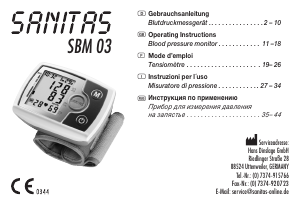
Настройка времени и даты
Вы обязательно должны настроить время и дату. Только при
этом Вы можете правильно вводить в память результаты
измерений с временем и датой и позднее вызывать их.
Время показывается в 24-часовом формате.
Примечание: Если Вы удерживаете кнопку „M» нажатой,
Вы можете настроить значения быстрее.
• Нажмите одновременно кнопки „ » и „M» . Индикация
месяца начинает мигать. Настройте кнопкой „M» месяц
от 1 до 12 и подтвердите выбор кнопкой „ » .
• Настройте день, час и минуту кнопкой и подтвердите
выбор кнопкой „ » .
5. Измерение кровяного давления
Наложить манжету
• Оголите левое запястье. Следите за тем, чтобы
кровообращению в руке не препятствовала слишком
тесная одежда и т. п. Наложите манжету на внутреннюю
сторону запястья.
• Зафиксируйте манжету лентой-липучкой таким образом,
чтобы верхний край аппарата находился приблизительно
на 1 см выше подушечки у основания большого пальца.
• Манжета должна плотно прилегать к запястью, но не
резать его.
Внимание! Эксплуатация прибора допускается только с
оригинальной манжетой.
Принять правильное положение
• Перед
каждым
расслабляйтесь в течение около
5 минут! В противном случае
возникают неточности измерения.
• Вы можете проводить измерение
сидя или лежа. Обязательно
установите руку на опору и согните
ее. В любом случае следите за тем, чтобы манжета
находилась на уровне сердца. В противном случае
возникают значительные неточности измерения.
Расслабьте руку и ладонь.
• Для того, чтобы получить точные результаты измерений,
необходимо вести себя спокойно и не разговаривать во
время измерения
Выполнить измерение кровяного давления
• Включите аппарат нажатием кнопки „ » .
• Перед измерением на короткое время появляется
последний сохраненный результат измерения. Если в
34
измерением
• • • • • • • • • • • • •
41
классифицировать и оценить, как указано в
нижеследующей таблице.
Пиктограмма на дисплее и шкала на аппарате
указывают, в каком диапазоне находится измеренное
кровяное давление.
Если значения для систолы и диастолы находятся
в двух различных диапазонах по классификации
ВОЗ (например,систола в диапазоне «Высокое
нормальное», а диастола в диапазоне «Нормальное»),
то график в аппарате всегда указывает более
высокий диапазон, в описанном примере – «Высокое
нормальное».
6. Сохранение, вызов и удаление
результатов измерения
• Результаты каждого успешного измерения
сохраняются в памяти вместе с датой и временем.
При более чем 60 результатах самый старый
результат удаляется.
• Для вызова результатов измерения нажмите
кнопку ввода в память „M“. Прибор вначале
указывает число занятых ячеек памяти, а
затем автоматически переходит к последнему
сохраненному результату измерения.
При дальнейших нажатиях кнопки ввода в память
„M“ показываются последние результаты
измерений с датой, временем и графическим
представлением классификации ВОЗ.
• Вы можете стереть память, нажав кнопку ввода
„M“и удерживая ее 3 секунды.
7. Сообщения о неисправностях/
Устранение неисправностей
При неисправностях на дисплее появляется сообщение
«Er_».
Сообщения о неисправностях могут появляться, если
• накачивание длится более 3 минут (на дисплее
появляется Er6),
• манжета наложена слишком сильно или слишком слабо
(на дисплее появляется Er3 или Er4),
• значение артериального давления чрезвычайно высокое
или чрезвычайно низкое (на дисплее появляется Er1 или Er2),
• давление накачивания превышает 300 мм рт. ст. (на
дисплее появляется Er5),
• имеется неисправность системы или прибора (на дисплее
появляется Er0, Er7, Er8, Er9, ErA или ErB)
• батарейки почти полностью разряжены, батарейки
необходимо заменить.
В этих случаях повторите измерение.
При необходимости, заново установите батарейки или
замените старые.
8. Уход за аппаратом
• Осторожно очищайте аппарат слегка смоченной
тряпкой.


